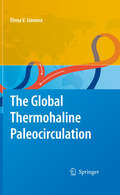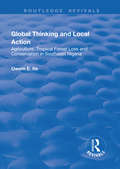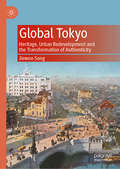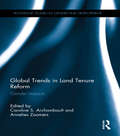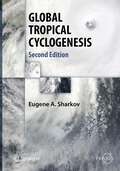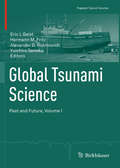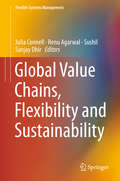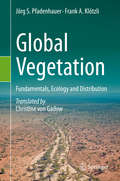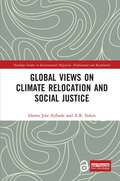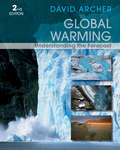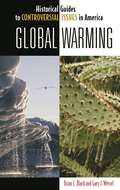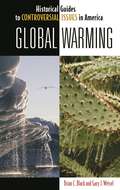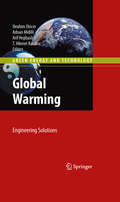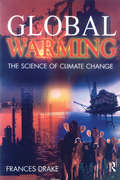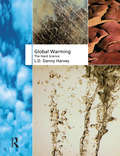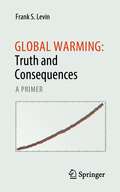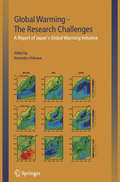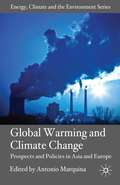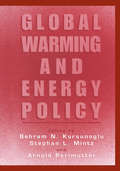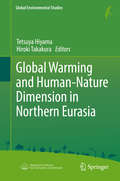- Table View
- List View
The Global Thermohaline Paleocirculation
by Elena IvanovaOriginally published in Russian in 2006, this is the first English translation of this important book on paleoceanography and paleoclimatology. Its initial publication was followed by a surge of interest in this subject prompting the author to revise and translate her original work. In the book, she successfully summarizes her own research over recent years and compiles an overview of up-to-date knowledge on past ocean circulation. The key topics include: - Modern thermohaline circulation and main stages of its development during the Cenozoic - Methods and proxies of paleoceanographic reconstruction - Variability of the meridional overturning circulation and paleoceanographic events in the North Atlantic during the last climatic cycle - Influence of the global thermohaline circulation on paleoceanographic events in the Eurasian Arctic seas, the Northern Indian Ocean, and the South China Sea - The role of the thermohaline circulation in global teleconnections in the Antarctic, Eurasian Arctic, northern Pacific and low latitudes Indo-Pacific. Comprehensive investigation of hundreds of international publications and her own results, convinced the author that the global thermohaline circulation controls the remote teleconnections on millennial-scale and partly on centennial-scale, while short-term climate signals are mainly transferred by the atmosphere. This revised and extended English edition provides the latest unpublished data, new figures and modeling results. The extensive reference list contains more than 100 publications and 140 new references.
Global Thinking and Local Action: Agriculture, Tropical Forest Loss and Conservation in Southeast Nigeria (Routledge Revivals)
by Uwem E. IteThis title was first published in 2001. Based on extensive local field research undertaken in and around the Cross River National Park in Nigeria, this book provides a socio-economic study of the tensions between agriculture and nature conservation. Taking a ’bottom-up’ approach and focussing on the farm household and the dynamics of forest farming at household level, it brings together a wealth of new information on the subject of tropical forestry, the causes and dynamics of tropical rain forest loss and the problematic relations between conservation authorities in National Parks and local people. Its conclusions raise important questions about practical ways forward in the development of such areas.
Global Thinking and Local Action: Agriculture, Tropical Forest Loss and Conservation in Southeast Nigeria (Routledge Revivals)
by Uwem E. IteThis title was first published in 2001. Based on extensive local field research undertaken in and around the Cross River National Park in Nigeria, this book provides a socio-economic study of the tensions between agriculture and nature conservation. Taking a ’bottom-up’ approach and focussing on the farm household and the dynamics of forest farming at household level, it brings together a wealth of new information on the subject of tropical forestry, the causes and dynamics of tropical rain forest loss and the problematic relations between conservation authorities in National Parks and local people. Its conclusions raise important questions about practical ways forward in the development of such areas.
Global Tokyo: Heritage, Urban Redevelopment and the Transformation of Authenticity
by Jiewon SongThis book examines heritage-led regeneration and decision-making processes in Tokyo’s urban centres of Nihonbashi and Marunouchi. Detailing some of the city’s most prominent and recent redevelopment projects, Jiewon Song recognizes key institutions and actors; their collective actions as placemakers; and how they project the authenticity of urban places in planning processes. Song argues that heritage-led regeneration tends to monopolize authenticity by weakening the visibility of other cultural and historic qualities in urban places. Authenticity consequently turns into a singular entity leading to the homogenization of urban places. As cities increasingly seek authenticity in the urban age, nation-states initiate top-down processes to achieve such ends, interweaving nationalism and national narratives into placemaking practices. In this fashion, Song challenges existing scholarship on urban conservation, global cities and the notion of authenticity.
Global Trends in Land Tenure Reform: Gender Impacts (Routledge ISS Gender, Sexuality and Development Studies)
by Caroline S. Archambault Annelies ZoomersThis book explores the gendered dimensions of recent land governance transformations across the globe in the wake of unprecedented pressures on land and natural resources. These complex contemporary forces are reconfiguring livelihoods and impacting women’s positions, their tenure security and well-being, and that of their families. Bringing together fourteen empirical community case studies from around the world, the book examines governance transformations of land and land-based resources resulting from four major processes of tenure change: commercial land based investments, the formalization of customary tenure, the privatization of communal lands, and post-conflict resettlement and redistribution reforms. Each contribution carefully analyses the gendered dimensions of these transformations, exploring both the gender impact of the land tenure reforms and the social and political economy within which these reforms materialize. The cases provide important insights for decision makers to better promote and design an effective gender lens into land tenure reforms and natural resource management policies. This book will be of great interest to researchers engaging with land and natural resource management issues from a wide variety of disciplines, including anthropology, sociology, development studies, and political science, as well as policy makers, practitioners, and activists concerned with environment, development, and social equity.
Global Trends in Land Tenure Reform: Gender Impacts (Routledge ISS Gender, Sexuality and Development Studies)
by Caroline S. Archambault Annelies ZoomersThis book explores the gendered dimensions of recent land governance transformations across the globe in the wake of unprecedented pressures on land and natural resources. These complex contemporary forces are reconfiguring livelihoods and impacting women’s positions, their tenure security and well-being, and that of their families. Bringing together fourteen empirical community case studies from around the world, the book examines governance transformations of land and land-based resources resulting from four major processes of tenure change: commercial land based investments, the formalization of customary tenure, the privatization of communal lands, and post-conflict resettlement and redistribution reforms. Each contribution carefully analyses the gendered dimensions of these transformations, exploring both the gender impact of the land tenure reforms and the social and political economy within which these reforms materialize. The cases provide important insights for decision makers to better promote and design an effective gender lens into land tenure reforms and natural resource management policies. This book will be of great interest to researchers engaging with land and natural resource management issues from a wide variety of disciplines, including anthropology, sociology, development studies, and political science, as well as policy makers, practitioners, and activists concerned with environment, development, and social equity.
GLOBAL TROPICAL CYCLOGENESIS (Springer Praxis Books)
by Eugene A. SharkovCyclogenesis research is a central issue of meteorology and climatology. This book gives a deep specific view and fundamentally and effectively contributes to the discussion of the problem. It treats cyclogenisis as a stochastic process in a very fundamental way. Since the publication of the first edition of Global Tropical Cyclogenesis in 2001, a number of important scientific results has been obtained using methods and techniques proposed in that first edition. There is therefore a great need for a revised 2nd edition of this book. It is based on scientific findings from the performance of satellite data processing and a series of scientific marine expeditions to the tropics as part of major Russian Science Academy research projects. Professor Eugene A. Sharkov has proposed the main approaches, experimental techniques and theoretical explanations for many scientific findings as well as new methods of satellite processing. He is recognized as a leading scientist in the field of microwave remote sensing of terrestrial surfaces and atmosphere and in nonlinear geophysics (origination and evolution of atmospheric catastrophes) and has published around 100 scientific works on the problems of global tropical cyclogenesis structure and evolution.
Global Tsunami Science: Past and Future, Volume I (Pageoph Topical Volumes)
by Eric L Geist Hermann M. Fritz Alexander B. Rabinovich Yuichiro TaniokaTsunami science has evolved significantly since the occurrence of two of the most destructive natural disasters in recent times: the 26 December 2004 Sumatra tsunami that killed about 230,000 people along the coasts of 14 countries in the Indian Ocean and the 11 March 2011 Tohoku (Great East Japan) tsunami that killed almost 20,000 people and destroyed the Fukushima Daiichi nuclear power plant. As a result of these and many other destructive tsunamis that have occurred over just the last decade, scientists from around the world have come together to engage in tsunami research. The global community of researchers has also expanded by discipline, adapting advances in other sciences to study all aspects of tsunami hydrodynamics, detection, generation, and probability of occurrence. The papers presented in this first of two topical volumes of Pure and Applied Geophysics reflect the state of tsunami science during this time. Nine papers examine various aspects of tsunami hazard and risk assessment. Five papers present new methods for tsunami warning and detection and six other papers describe new methods for understanding tsunami hydrodynamics. The final five papers of the volume describe tsunamis generated by non-seismic sources and important case studies. Collectively, this volume highlights contemporary trends in global tsunami science, both fundamental and applied toward hazard assessment and mitigation. The volume is of interest to scientists and practitioners involved in all aspects of tsunamis from source processes to coastal impacts. Postgraduate students in geophysics, oceanography and coastal engineering – as well as students in the broader geosciences, civil and environmental engineering – will also find the book to be a valuable resource, as it combines recent case studies with advances in tsunami science and natural hazards mitigation.
Global Value Chains, Flexibility and Sustainability (Flexible Systems Management)
by Julia Connell Renu Agarwal Sushil Sanjay DhirThis book provides a conceptual framework of global value chains, flexibility and sustainability, supported by research projects, case applications and models in various related areas organized into three parts. In the first part of the book, various authors discuss how to improve the efficiency and effectiveness of global value chains through various types of analyses. While the focus is on cluster management, and mergers and joint ventures, the legal aspects of control and liability concerning the integration of value chains, is also examined in one of the contributions. The second part includes chapters concerning ‘Strategy and Flexibility’. Strategies concern topics such as inventory management, talent management, strategic alignment, decision making, behavioural change and HR systems. The third and final part of the volume concerns the topic of ‘Sustainability’, wherein the contributions focus on various initiatives intended to promote sustainability across respective value chains bearing in mind the concept of flexibility. The book is a valuable resource for a varied audience, ranging from management students and researchers, to practicing business managers, as well as for professional institutions, consultants, and corporate organizations.
Global Vegetation: Fundamentals, Ecology and Distribution
by Jörg S. Pfadenhauer Frank A. KlötzliThis up-to-date textbook of global vegetation ecology, which comprises the current state of knowledge, is long overdue and much-needed. It is a translation of the textbook “Vegetation der Erde” (Springer-Spektrum, Heidelberg). A short introductory chapter deals with the fundamentals of vegetation ecology that are of importance for the delimitation and characterization of the global vegetation presented in this book (chorology, evolution of plants, physiognomic and structural characteristics, phytodiversity and the human impact on it as well as general terminology concerning both plant growth forms and on vegetation structure types). In the following chapters the zonal and azonal vegetation from the tropics to the polar regions including high mountains is described and discussed. The main focus is on the characterization of interactions between the spatial location of plants and plant communities on the one hand and site conditions, historic and genetic processes, spatial and temporal patterns, ecophysiology and anthropogenic influences on the other hand. Additional information on specific topics is provided in 51 boxes.
Global Views on Climate Relocation and Social Justice: Navigating Retreat (Routledge Studies in Environmental Migration, Displacement and Resettlement)
by Idowu Jola Ajibade A. R. SidersThis edited volume advances our understanding of climate relocation (or planned retreat), an emerging topic in the fields of climate adaptation and hazard risk, and provides a platform for alternative voices and views on the subject. As the effects of climate change become more severe and widespread, there is a growing conversation about when, where and how people will move. Climate relocation is a controversial adaptation strategy, yet the process can also offer opportunity and hope. This collection grapples with the environmental and social justice dimensions from multiple perspectives, with cases drawn from Africa, Asia, Australia, Oceania, South America, and North America. The contributions throughout present unique perspectives, including community organizations, adaptation practitioners, geographers, lawyers, and landscape architects, reflecting on the potential harms and opportunities of climate-induced relocation. Works of art, photos, and quotes from flood survivors are also included, placed between sections to remind the reader of the human element in the adaptation debate. Blending art – photography, poetry, sculpture – with practical reflections and scholarly analyses, this volume provides new insights on a debate that touches us all: how we will live in the future and where? Challenging readers’ pre-conceptions about planned retreat by juxtaposing different disciplines, lenses and media, this book will be of great interest to students and scholars of climate change, environmental migration and displacement, and environmental justice and equity.
Global Views on Climate Relocation and Social Justice: Navigating Retreat (Routledge Studies in Environmental Migration, Displacement and Resettlement)
by Idowu Jola Ajibade A. R. SidersThis edited volume advances our understanding of climate relocation (or planned retreat), an emerging topic in the fields of climate adaptation and hazard risk, and provides a platform for alternative voices and views on the subject. As the effects of climate change become more severe and widespread, there is a growing conversation about when, where and how people will move. Climate relocation is a controversial adaptation strategy, yet the process can also offer opportunity and hope. This collection grapples with the environmental and social justice dimensions from multiple perspectives, with cases drawn from Africa, Asia, Australia, Oceania, South America, and North America. The contributions throughout present unique perspectives, including community organizations, adaptation practitioners, geographers, lawyers, and landscape architects, reflecting on the potential harms and opportunities of climate-induced relocation. Works of art, photos, and quotes from flood survivors are also included, placed between sections to remind the reader of the human element in the adaptation debate. Blending art – photography, poetry, sculpture – with practical reflections and scholarly analyses, this volume provides new insights on a debate that touches us all: how we will live in the future and where? Challenging readers’ pre-conceptions about planned retreat by juxtaposing different disciplines, lenses and media, this book will be of great interest to students and scholars of climate change, environmental migration and displacement, and environmental justice and equity.
Global Warming: Understanding the Forecast
by David ArcherBased on the author's highly successful undergraduate course taught at the University of Chicago, Global Warming presents the processes of climate change and climate stability. Drawing on a wide range of disciplines, this Second Edition not only summarizes scientific evidence, but also presents economic and political issues related to global warming.
Global Warming (Historical Guides to Controversial Issues in America)
by Brian C. Black Gary J. WeiselTracing scientific ideas about the structure of Earth, Global Warming creates an intellectual portrait of the shifts in thinking that have led to the current controversy, enabling readers to make up their own minds on this important issue.Global Warming takes one of the hot-button issues of our time and surveys it in historical context, creating an intellectual portrait of the multi-century shifts in thinking that have led to gradual acceptance of the concept. The book summarizes pertinent aspects of geology, earth science, and climate science in easy-to-read terms. It then frames this background in terms of cultural and social shifts, including the Industrial Revolution, conspicuous consumption, and modern environmentalism. In addition, a study of the ebb and flow of cultural and political reception relates the issue to religious and social ideas.The information presented here will enable the reader to understand the scientific case stating that human activity has caused an unprecedented warming in the late 20th and early 21st centuries. Technical and political objections to this thesis are also covered, so that readers may form their own opinions on this critical subject.
Global Warming (Historical Guides to Controversial Issues in America)
by Brian C. Black Gary J. WeiselTracing scientific ideas about the structure of Earth, Global Warming creates an intellectual portrait of the shifts in thinking that have led to the current controversy, enabling readers to make up their own minds on this important issue.Global Warming takes one of the hot-button issues of our time and surveys it in historical context, creating an intellectual portrait of the multi-century shifts in thinking that have led to gradual acceptance of the concept. The book summarizes pertinent aspects of geology, earth science, and climate science in easy-to-read terms. It then frames this background in terms of cultural and social shifts, including the Industrial Revolution, conspicuous consumption, and modern environmentalism. In addition, a study of the ebb and flow of cultural and political reception relates the issue to religious and social ideas.The information presented here will enable the reader to understand the scientific case stating that human activity has caused an unprecedented warming in the late 20th and early 21st centuries. Technical and political objections to this thesis are also covered, so that readers may form their own opinions on this critical subject.
Global Warming: Engineering Solutions (Green Energy and Technology #33)
by Ibrahim Dincer Adnan Midilli Arif Hepbasli T. Hikmet KarakocGlobal Warming: Engineering Solutions goes beyond the discussion of what global warming is, and offers complete concrete solutions that can be used to help prevent global warming. Innovative engineering solutions are needed to reduce the effects of global warming. Discussed here are proposed engineering solutions for reducing global warming resulting from carbon dioxide pollution, poor energy and environment policies and emission pollution. Solutions discussed include but are not limited to: energy conversion technologies and their advantages, energy management and conservation, energy saving and energy security, renewable and sustainable energy technologies, emission reduction, sustainable development; pollution control and measures, policy development, global energy stability and sustainability.
Global Warming
by Frances DrakeFirst published in 2000. Routledge is an imprint of Taylor & Francis, an informa company.
Global Warming: The Science Of Climate Change (A\hodder Arnold Publication)
by Frances DrakeFirst published in 2000. Routledge is an imprint of Taylor & Francis, an informa company.
Global Warming
by L. D. HarveyGlobal Warming: The Hard Science presents a comprehensive, qualitatively rigorous, and critical discussion of the science underlying the global warming issue. The major processes in the climate system needed to understand projected human-induced climatic change are presented in detail. Observational systems used to monitor changes in the climate system and the ways in which the raw data are analyzed in order to produce estimates of current trends are also critically reviewed. The author discusses the hierarchy of computer models used to project changes in the carbon cycle, in climate, and in sea level and examines the physical principles underlying the greenhouse effect and projected warming. The text also presents a detailed discussion of the carbon cycle, of climate sensitivity, and of projected patterns of climatic change through time. Sea level rise and issues of risk and potential surprises are also critically assessed. Emphasis is placed throughout on developing an intuitive understanding of those results that do not depend on the details of any one computer simulation model. A series of boxes illustrate the key points through step-by-step calculations.
Global Warming
by L. D. HarveyGlobal Warming: The Hard Science presents a comprehensive, qualitatively rigorous, and critical discussion of the science underlying the global warming issue. The major processes in the climate system needed to understand projected human-induced climatic change are presented in detail. Observational systems used to monitor changes in the climate system and the ways in which the raw data are analyzed in order to produce estimates of current trends are also critically reviewed. The author discusses the hierarchy of computer models used to project changes in the carbon cycle, in climate, and in sea level and examines the physical principles underlying the greenhouse effect and projected warming. The text also presents a detailed discussion of the carbon cycle, of climate sensitivity, and of projected patterns of climatic change through time. Sea level rise and issues of risk and potential surprises are also critically assessed. Emphasis is placed throughout on developing an intuitive understanding of those results that do not depend on the details of any one computer simulation model. A series of boxes illustrate the key points through step-by-step calculations.
Global Warming: A Primer
by Frank S. LevinGlobal Warming: Truth and Consequences is a guidebook for persons who are unfamiliar with the relevant details but want to know what anthropogenic global warming and its repercussions entail. The first chapter presents background material on the earth’s climate system and some of the global warming rejecters’ claims and their refutations, including the evidence underlying the reality of anthropogenic global warming. The next chapter examines in detail many of the global warming’s contemporaneous and deleterious repercussions, while the final one considers some future scenarios and their likely consequences, some of which are from the latest IPCC Reports. It also presents a number of the proposed steps to avoid these consequences and the problems of implementing them.
Global Warming — The Research Challenges: A Report of Japan’s Global Warming Initiative
by Atsunobu IchikawaOf interest to both researchers and policy makersSuitable for course use
Global Warming and Climate Change: Prospects and Policies in Asia and Europe (Energy, Climate and the Environment)
by A. MarquinaThis compendium looks at Asian and European policies for dealing with climate change, and possible impacts on conflicts and security. It clarifies the impacts of climate change on natural resources, on the frequency and expansion of natural disasters and the repercussions for environmentally-induced migration.
Global Warming and Energy Policy
by Behram N. Kursunogammalu Stephan L. Mintz Arnold PerlmutterThe first part of the conference explores two major environmental concerns that arise from fuel use: (1) the prospect that the globe will become warmer as a result of emissions of carbon dioxide, and (2) the effect upon health of the fine particles emitted as combustion products. The conference focused on the fact that there was lack of data direct enough to enable us to predict an entirely satisfactory result, and that makes policy options particularly difficult. With regard to (1) above, in the second half of the 20th century there were major increases in anthropogenic C02 emissions, and it is generally agreed that these were responsible for an increase in C02 concentrations. But the relationship between global temperature and CO2 concentrations remains murky. The principal problem is that water vapor is a more important greenhouse gas than C02 and that the concentrations of water vapor vary widely in time and space. The approach to this problem is probably, but not certainly, a positive feedback effect: as temperature increases so does the water vapor leading to further temperature increases. Scientists associated with the Intergovernmental Panel on Climate Change (IPCC) tend to believe the general features of the models. Other scientists are often less convinced.
Global Warming and Human - Nature Dimension in Northern Eurasia: Nature Dimension In Northern Eurasia (Global Environmental Studies)
by Tetsuya Hiyama Hiroki TakakuraThis book describes the current environmental changes due to global warming in northern Eurasia, especially focusing on eastern Siberia. Spring flooding, ice-jam movements, and monitoring using remote sensing are included. Additionally, current reindeer herding of indigenous peoples in Siberia and related environmental changes such as waterlogging, rising temperatures, and vegetation changes are addressed. As a summary, the book also introduces readers to adaptation strategies at several governmental levels.The book primarily focuses on 1) introducing readers to global warming and human-nature dynamics in Siberia, with special emphasis on humidification of the region in the mid-2000s, and 2) describing social adaptation to the changing terrestrial ecosystem, with an emphasis on water environments. Adaptation strategies based on vulnerability assessments of environmental changes in northern Eurasia are crucial topics for intergovernmental organizations, such as the IPCC (Intergovernmental Panel on Climate Change). Thus, the book offers a valuable resource not only for environmental researchers but also for several stakeholders regarding global environmental change.
